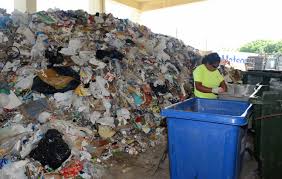If you live in a developed nation, chances are companies in your country dispose of quite literally tons of hazardous waste products every day. Sadly, much of this waste is not dealt with properly, and can come back to haunt us. Anything from a wadded-up bubble gum wrapper to radioactive waste, if left unchecked, can leave a huge and damaging footprint on our ecosystems.
In order to understand exactly the impact hazardous waste disposal has on our environment, let’s take a look at what chemicals and hazardous waste actually are, the effects they have in both the short and long term, and what governments are doing about it.
What Are Chemicals?
The simplest definition of a chemical is a substance that cannot be broken down into simpler parts without changing it into something else through a reaction. A chemical is a pure substance, and can be a gas, liquid or solid. It may either consist of an element, or of a molecule or compound that is uniform in nature. Chemicals can occur naturally or we can manufacture them artificially in laboratory settings.
Chemicals have varying effects. Many chemicals are used to improve the quality of our lives and most are not harmful to the environment or human health. However, some chemicals have the potential to cause harm, in certain amounts, and should only be used when the potential risks are appropriately managed.
What Is Hazardous Waste?
So, what is the difference between a chemical and a true hazardous waste? In short, a chemical isn’t necessarily harmful.
On the other hand, anything that has been thrown away that can still potentially harm its surroundings and those who dwell in them is considered hazardous waste. This can be anything from chemical waste and materials left over from manufacturing to household garbage such as cleaning solutions, batteries and non-biodegradable plastics.
Unfortunately, a lot of what companies and individuals throw away in the United States (and across the world) meets that definition. In fact, hazardous waste makes up an estimated 15 percent of disposed materials per year. When you multiply 15 percent by the amount of waste each person in America produces, that’s a staggering amount of hazardous materials flowing into our environment every day.

How Has Hazardous Waste Impacted the Environment?
Hazardous waste has enormous impacts on the environment. Air, soil, water and wildlife health are all affected by the amounts of hazardous waste generated every day by business and industry. Regulations exist to help us dispose of it properly, but contamination still occurs all the time. In fact, the U.S. Environmental Protection Agency (EPA) recorded 23 million cases of voluntary disclosure of pollution risks and opened 387 environmental criminal cases in 2009. This has effects in both the short and the long run.
- Short-Term Effects on the Environment
The main danger in the short term is water pollution. The chemicals that pour into our waterways make streams, rivers, lakes and aquifers unsafe to use for drinking or agricultural purposes. Animals and plants sicken and die when they drink from these waters, and human health in areas downstream may be affected. However, it is the long-term results that truly terrify.
- Long-Term Effects on the Environment
Long-term effects include signs of mutation in animals, cancer and other diseases in humans, trash in our waterways and green spaces, and the destruction of many natural resources. Populations of insects such as bees, which are crucial to preserving the fertility of plant life, are dying off faster than they can repopulate due to human pollution.
How Does Hazardous Waste Affect Human and Animal Health?
Because bodily fluids are another kind of hazardous waste that often gets disposed of improperly, we now have to worry about the spread of human disease as well. Other forms of chemical contamination, such as mercury and lead, pose major human health risks – especially to developing children. They accumulate in tissue, build up over time, and can lead to cancer, seizures, poisoning and death.
Hazardous Waste and Global Warming
Emissions pour into the air every single day from both primary businesses and the secondary waste treatment plants that help to mitigate pollution. These chemicals destroy the ozone, which then warms the Earth and causes hazardous wastes to impact the Earth in new ways, wrecking now more-fragile ecosystems. Climate change may even expose hazardous wastes once thought locked away, such as in abandoned Soviet strongholds.
What Is the Government Doing to Protect Our Environment?
Hazardous waste has another big impact: on our pockets. Improper disposal of waste of any kind has to be rectified and paid for out of the pocket of the state – and, therefore, the pockets of taxpayers. If we want to avoid this, we must keep supporting government initiatives that offer clear guidelines about waste disposal to citizens. We must also support waste disposal measures that guide pharmaceutical, nuclear, imported, electronic and other forms of waste. Luckily, the government is putting these measures in place in ever-greater numbers.

What Can We Do To Combat The Harmful Effects Of Hazardous Waste?
While many developed nations, especially in North America, have established organizations to combat the growing negative impact of hazardous waste both on land and in our waters, it is paramount that companies learn the proper steps to handling hazardous waste to minimize the risk of pollution and damage to both individuals and ecosystems alike. This entails abiding by proper hazardous waste disposal protocols, especially for toxic materials such as blood, medical equipment, and radioactive waste.
Hazardous waste disposal is critically important to the environment and your business operations. Trying to determine how to dispose of your hazardous waste on your own, usually ends up with disastrous results and heavy fines. Look for a hazardous waste transporter, like Action Hazmat Companies, that is both licensed, bonded and has adequate insurance to ensure your company is protected to the fullest possible extent.

